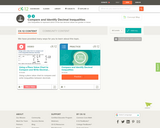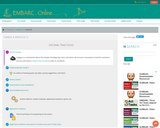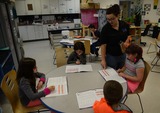
Here are tasks aligned to 4.NF.7
- Subject:
- Mathematics
- Material Type:
- Activity/Lab
- Formative Assessment
- Author:
- Drew Polly
- Date Added:
- 07/24/2020

Here are tasks aligned to 4.NF.7

This parent guide supports parents in helping their child at home with the 4th grade Math content. Within the folder you will access Parent Guide PDFs in FIVE Languages: Arabic, English, Hindi, Spanish, and Vietnamese to help on-going communication with caregivers.

This resource accompanies our Rethink 4th Grade Math course. It includes ideas for use, ways to support exceptional children, ways to extend learning, digital resources and tools, tips for supporting English Language Learners and students with visual and hearing impairments. There are also ideas for offline learning.

An assessment aligned to 4.NF.6 and 4.NF.7.

This short video and interactive assessment activity is designed to teach second graders about using a place value chart to compare and write decimal inequalities.

This short video and interactive assessment activity is designed to teach second graders an overview of comparing decimals.

Students compare two decimals to hundredths by reasoning about their size, recognize that comparisons are valid only when the two decimals refer to the same whole, and record the results of comparisons with the symbols >, <, or =.

This lesson is for grades 4-5 on math. At Home Learning Lessons are a partnership between the North Carolina Department of Public Instruction, PBS North Carolina, and the William and Ida Friday Institute for Educational Innovation. Each lesson contains a video instructional lesson, a PDF lesson plan with a transcript, and a PDF file of extension activities.

For this online interactive, students use comparison symbols (<,>, and =) to compare numbers with up to two numbers after the decimal. Students have the option to skip the problem or check their answer before submitting it. Their progress is tracked and shown above each problem.

This resource helps you to pre-plan intentional lessons. It can be used for any lesson, but the lesson itself was intended when planning for tasks.

Using the online interactives students will order the dollar amounts from least to greatest. Students
have the option to skip the problem or check their answer before submitting it. Their progress is tracked and shown above each problem.

Exit tickets for 4.NF.6.

Exit tickets for 4.NF.7.

G4M6: Decimal Fractions. Contains 16 Lessons.

This unit is for an EC pull-put sixth grade math class. Students will represent the same value as a fraction, decimal, and percentage as they label each continent on a map with the percentage of the world's population in each continent, based on information from the book, "If the World Were a Village." Students will discuss the distribution of populations around the globe and how that impacts those areas of the world differently.This lesson was developed by Virginia Campbell as part of their completion of the North Carolina Global Educator Digital Badge program. This lesson plan has been vetted at the local and state level for standards alignment, Global Education focus, and content accuracy.

This unit is for an EC pull-put sixth grade math class. Students have a discussion connecting their lives to the globe. They then discuss the concept of scale as it relates to maps/globes and the book "If the World Were a Village." Finally they use a graphic organizer to predict what the book is going to tell them about the people of the world.This lesson was developed by Virginia Campbell as part of their completion of the North Carolina Global Educator Digital Badge program. This lesson plan has been vetted at the local and state level for standards alignment, Global Education focus, and content accuracy.

This unit is for an EC pull-put sixth grade math class. Students present their poster projects to the class, and then write a reflection responding to the unit.This lesson was developed by Virginia Campbell as part of their completion of the North Carolina Global Educator Digital Badge program. This lesson plan has been vetted at the local and state level for standards alignment, Global Education focus, and content accuracy.

This unit is for an EC pull-put sixth grade math class. Teacher will model how to create a pie chart using data from the book, "If the World Were a Village." Then the class will create a pie chart together as guided practice. The class will draw conclusions about peoples' different experiences and perspectives from the data in the chart. The teacher will introduce the poster project to the students, and they will select a set of data from the book to create their own pie chart with. This lesson was developed by Virginia Campbell as part of their completion of the North Carolina Global Educator Digital Badge program. This lesson plan has been vetted at the local and state level for standards alignment, Global Education focus, and content accuracy.

This unit is for an EC pull-put sixth grade math class. In this lesson students create a pie chart from their chosen set of data and work on the other elements of the poster project, including interpreting and explaining the data.This lesson was developed by Virginia Campbell as part of their completion of the North Carolina Global Educator Digital Badge program. This lesson plan has been vetted at the local and state level for standards alignment, Global Education focus, and content accuracy.

This lesson focuses on plotting decimals on number lines.